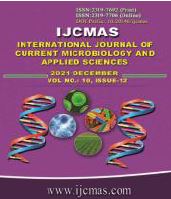


 National Academy of Agricultural Sciences (NAAS)
National Academy of Agricultural Sciences (NAAS)

|
PRINT ISSN : 2319-7692
Online ISSN : 2319-7706 Issues : 12 per year Publisher : Excellent Publishers Email : editorijcmas@gmail.com / submit@ijcmas.com Editor-in-chief: Dr.M.Prakash Index Copernicus ICV 2018: 95.39 NAAS RATING 2020: 5.38 |
The disease appears in the field in patches at both seedling and adult stages. Seedling wilt is characterized by sudden drooping, followed by drying of leaves and seedling death. The roots appear healthy, with reduced proliferation and nodulation and usually no internal discoloration of the vascular system. The fungus Fusarium oxysporum f. sp. lentis is septate, profusely branched growth on potato sucrose / dextrose agar at 25ºC, initially white turning light buff or deep brown later and fluffy or submerged. The growth becomes felted or wrinkled in old cultures. Various types of pigmentation (yellow, brown, whitish /cream, crimson dark purple, light orange) may be observed in culture on solid medium. Microconidia were usually borne on simple and short conidiophores, which arise laterally on the hyphae. They are oval to cylindrical, straight or curved and measure 2.5 - 3.5 x 5 - 11µm. Macroconidia are borne on branched conidiophore, thin walled, 1 to 6 septate, fusoid, pointed at both ends and measures 3.5 -4.5 x 25 - 65µm. Chlamydospores are formed in old cultures, which are smooth or rough walled, terminal intercalary and may be formed singly or in pairs or in chains. The pathogen causes a lesion localized at or about the collar between the stem and the root. The lesions develop around the stem eventually forming a "collar" region.
 |
 |
 |
 |
 |